$2M+ of lies to win power
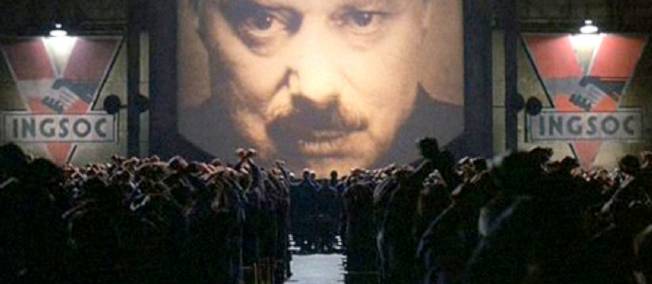
I believe in truth in advertising. So does the commercial TV regulator that demands evidence for any claim you want to make before they give your ad clearance to air. Unfortunately for the voters of NSW, political parties are allowed to say what they want in an ad because they aren't answerable to any of the rules mere brands and businesses have to conform to.
If I made a fraudulent claim for a client in an ad, (for instance the kind of price saving offer mobile phone plans were notorious for before being fined into transparent pricing), the ACCC or ASIC would come after me. This election has seen Labor and unions spend twice the Liberals. Most of that $2,500,000 was on ads that say electricity prices will go up if Baird sells 49% of the poles and wires. It's a lie.
Their ads scream this lie despite ACCC chairman Rod Simms saying this isn't the case. Even the Australian Energy regulator is on record that whoever owns the poles and wires in NSW after the election he will insist they reduce their prices by 20-30% over the next five years. There is no evidence for the claim made in Labor's ads that I believe would have satisfied the broadcast standards that commercial advertisers have to comply with. In fact, there is much historic evidence from previous power privatisations showing prices are lower outside government ownership. This has been acknowledged by such Labor luminaries as Bob Carr, Morris Iemma, Michael Costa and Anna Bligh when they attempted to sell the poles and wires under their governments.
It frustrates me as a professional marketer that in the 21st century political parties of any persuasion can play 1984 mind games with the truth and run them in prime time. The ABC Fact Check merely called Foley's ad pitch "spin". I prefer the robust language of former Labor Energy Minister and ACTU president Martin Ferguson. He says Foley's spin is "rank opportunism and scaremongering... sending a clear message he doesn't care about jobs and energy security."
Politicians' ad claims are officially accountable to... themselves
Here is the law (or lack of) that applies to political advertising as published by adstandards:
"Currently, there is no legal requirement for the content of political advertising to be factually correct. Complainants are advised to raise their concerns with the advertiser directly and/or with their local Member of Parliament."
Maybe we should just ban political advertising, we banned cigarette ads for telling us porkies.
Read MoreThe optimum lengths of social media
People now have short attention spans. So to connect you have to cut through. Keep it honest. Keep it simple. And keep it true to your brand. As for length, keep it short.
71 - 100 characters
Posts with 40 characters get 86% more engagement
Google+
25 characters
40 characters
Linked In
Posts 16 to 25 words long
Videos
Average length watched is 2.7 minutes
Read MoreThe average customer has an attention span of

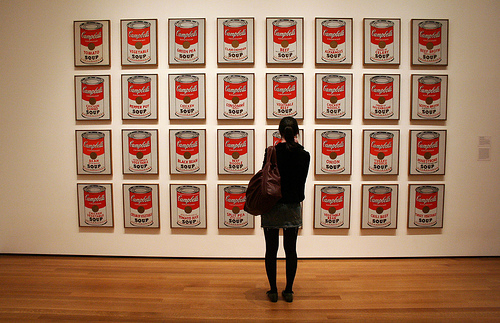
How does a brand catch a customer's interest when their attention span is now less than that of a goldfish? I spent a few seconds Googling to discover the average person's attention span has shrunk since 1998, by 11 minutes.
The average attention span today is 8 seconds
The National Center for Biotechnology Information says our attention span is now 1 second less than goldfish. What hope does a brand have to convince us to buy?
Consider a tube of toothpaste. The average main grocery buyer now spends less than 20 minutes in the supermarket for the big weekly shop. With over 10,000 items to choose from it's not surprising when faced with so many options brands are struggling to catch shoppers' interest. At the dental care section 27% of shoppers walk away without making a decision.
You may be aware Australians have never been better educated, the number of university graduates has almost quadrupled since 1986, from 6% to more than 21%. Are we any smarter or better prepared to make purchase decisions?
We are exposed to five times the quantity of information every day than we received 30 years ago, (you may be surprised just how many ads we are exposed to). Yet we have less free time to consider. The Economist explains that time poverty is a wealth syndrome, the more money we have the more we value our time and the more choices we are confronted with to spend that time. At the other extreme, cash strapped people have largely given up trying to decipher so much information, they are influenced by price like never before.
Price is increasingly winning over brand appeal. It's at the heart of the growing success of ALDI – less items to choose from, mostly unbranded, all at lower prices. This has seen their share of grocery sales reach 10%, a big slice of the market brands are mostly missing.
Even brands are struggling to be seen in Woolworths
According to Woolworths own research "more than a third of the items in Woolworths’ supermarket trolleys are purchased on promotion." That's an increase of 10% a year for the last two years.
"Australians hunting for bargains are the big winners, with one in four customers (25%) purchasing nearly half of the food and drinks in their trolley on special."
How do the retailers manipulate the time poor if not with price?
One journalist recently warned shoppers something brand marketers pay dearly for:
- The most expensive brands, or the ones being promoted heavily, will always be on the two shelves that sit between waist and shoulder height.
- Cheaper products are often stocked below knee height.
- Supermarkets know that you may only want milk so put it at the back of the store in the hope you’ll pick up items you don’t need.
Not only are the retailers asking brands for price rebates, Private Label substitutes are also catching once impregnable brands in a pincer movement. So if you believe in protecting the value of your brand you'll probably want to avoid discounting too often. Only the biggest and most desperate can afford to pay Coles and Woolies to be on promotion. In the past sales managers have encouraged the benefits of putting products on promotion to drive sales. Does it still work in the era of short attention spans?
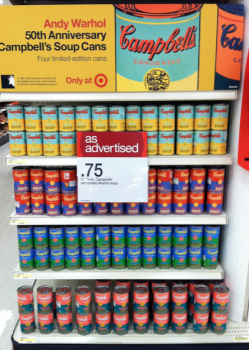
My associates at consumer benchmarking specialists B4P spent a year researching the impact of sales promotions at Point of Purchase (POP). The clients were several of the largest global FMCG companies that are active promoters in Australia's supermarkets, every week of the year. They tested awareness before promotion, cut through in-store, trial, impact on sales and recall several weeks later.
Across all promotion types, (price promotion, competitions, bundled offers and bonuses), shoppers generally don't notice any of it. This is despite multi-million dollar spends on displays, cardboard, posters, banners, gondola ends and shelf strips. Most in-store promotions have become invisible.
Earned and shared media can still gain attention
As we learned over seven years growing Pacific West from a $6million pa frozen seafood minnow to a $38million challenger brand, you can drive shoppers to your product by creating original content to tell your story and social media to spread the word. Just remember your audience has a short attention span. Here is a charming infographic that shows the optimum number of times to post content on social media channels.

Read More
Think big, or detail will kill your business


"Look, I said I'd bring you the report on micromanagement,
just give me a minute!"
Stop sweating the small stuff, especially now there's so much of it. New technologies allow us to gather data on just about everything. So it's become accepted practice for marketers and sales to invest in new ways to gather stats and report to senior management. For those of you wondering what's the point, it has now been proven the more a business spends on technology, CRM systems and sales data, the less well it performs in profitable conversions.
The more technology marketers use, the worse the results
Sounds like a contradiction, but the research undertaken by Peter Strohkorb into sales and marketing collaboration in 2013/4, simply proves the more systems teams add the worse the sales results. It's symptomatic of what the authors of Blue Ocean Strategy postulated over a decade ago. A typical strategic plan is usually based on a plethora of research from silos across the business which forces management to dwell on detail. Management becomes paralyzed by information overload.
The businesses that thrive are the ones that step back and look at the big picture using a customer centric view of what could be possible. Here's how it works.
Focus on the big picture to create a Blue Ocean Strategy
| Head to head competition | Blue Ocean creation | ||
| Industry | Focus on rivals within industry | Looks across alternative industries | |
| Strategic group | Focus on position against competitors | Looks across strategic groups | |
| Buyer group | Focus on better surving current buyers | Redifines who buyers can be | |
| Scope of product /service | Focus on costs/maximising value of current offer | Looks across complementary products/services | |
| Functional/emotional orientation | Focus on price/performance improvement | Rethinks the orientation of the industry | |
| Time | Reacts to industry changes as they happen | Participates in shaping external trends over time |
With a Blue Ocean strategy, you can implement a clear brand building campaign
We've found time and again, once clients re-visit what they can be, the task of growing the business becomes clear. Our methods to help create clear differentiation set the business up for challenger brand growth. With a single minded compelling tag line that sets them apart, big picture thinking helps refresh the business. There is new enthusiasm we harness to recreate the brand and relaunch. The way is now clear to become a price setter, not taker and drive sales conversions.
See some of the ways a refreshed brand can improve profitability.
Read MoreFor a nation of gamblers we're marketing risk averse
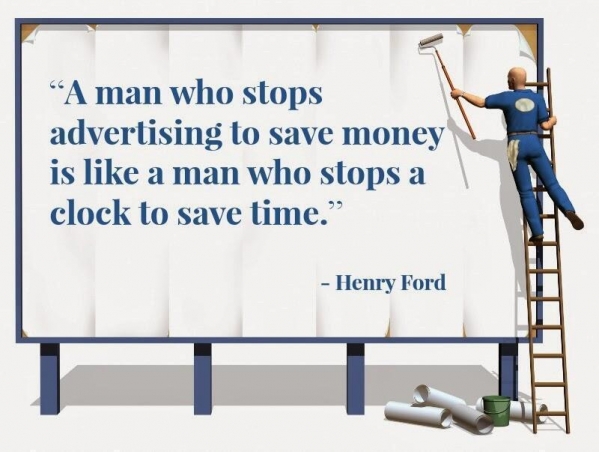
The companies that rated best for effective marketing, according to a recent Gartner study, were the ones that spent the most time understanding their customers. Businesses that are introspective and fearful of action will lose sales to those actively talking to customers and prospects.
How do you guarantee marketing success?
Jan-Patrick Schmitz, CEO of Montblanc North America, says "it obviously starts with the CEO. If he or she doesn’t understand that the business is about the customer and not operations, the CMO is going to have an uphill battle. Understanding your customer is about understanding what your business is and what your business will grow into.”
It's not a lottery, once you understand what customers want from your product or service, marketers that advocate for the customer in the boardroom will win.
Get the message right, then the risks are reduced irrespective of the mediums you then try. If you do understand your customers true needs and what they value most, and built your offer to satisfy those desires, it's time to check out the latest ways to advertise and connect.
Read MoreAussie business struggles, time for a creative way out


Will our kids ever be able to afford to buy a house? Can they even afford to rent? Here in Woolloomooloo 2 bed flats start at $1,000 a week, unfurnished! Unemployment is on the way up, mining investment on the way down. Coles and Woolies continue to squeeze farmers and FMCG brands while bricks and mortar retail is flat.
The big 4 banks are making record profits on higher margins than ever. If you are a small to medium business they probably won't give you a loan. 20 years ago 75% of bank lending was to business, now 75% goes to funding ballooning house prices.
This chart shows the decline in business investment post GFC
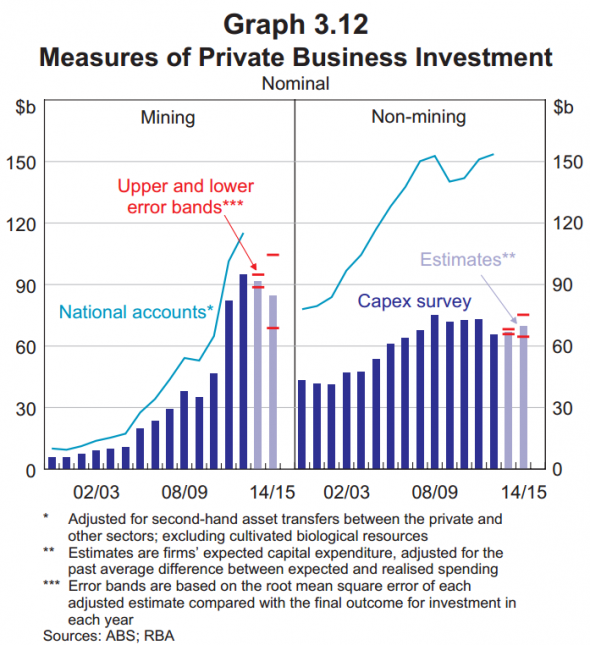
If businesses aren't investing in themselves, how can they grow let alone survive as the Internet destroys traditional business models?
Most managers have spent the last 6 years cutting and seeking efficiencies, hoping if they hang on long enough the market will recover. While local businesses seem to think it's conditions that are tough, World Bank figures show the world is booming – output was up $US75 trillion last year, which is about 20 per cent higher than the pre-GFC peak. 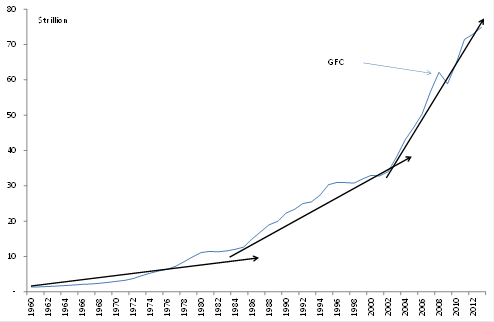
The world is moving on
Australians need to look outwards and recognise there isn't going to be a return to the way things were, the new reality is more rapid change and creative destruction. I use the word creative discerningly. It's the best way to describe the increasingly global competitive situation most businesses are struggling to get their heads around.
Historically change came slowly and could be managed by gradual adjustments of pricing, distribution or inputs. Not any more.
Enabled by the Internet, we now have Google replacing entire distribution channels with a search box. The Cloud has enabled brands such as Xero to offer with a lower cost and better service to leapfrog long established businesses like MYOB that relied on annual software upgrades. Social media has empowered determined consumers to "out" entrenched self-serving business practices, just look at CommBank's conflicted financial advice scandal that could cost it over $100million. (Or ANZ's Timbercorp scam and Macquarie's financial planners rort.)
These are all examples of a new business environment. New challenges require new thinking. A survey of over 300,0000 managers published by Harvard Business Review shows both CEOs and the next 3 levels of management aren't equipped to think outside the square.
The most important skills as rated by managers
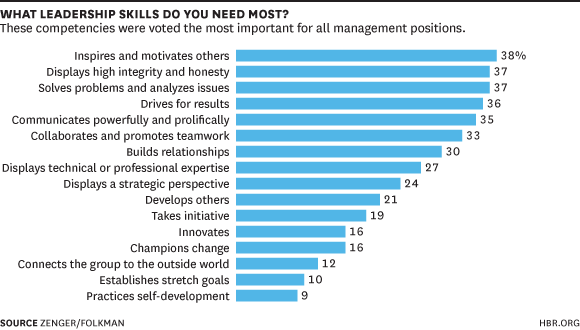
Perhaps the skills that are most needed today to deal with the rapid pace of change are the ones required to find creative ways to refresh and relaunch a business. Yet the survey found these are the least valued by management. Can you imagine how the people behind some of Australia's most successful businesses would rank themselves for the skills on the list? Like the young pair behind Atlassian, ten years ago a start up now worth $3.5billion. Or Boost Juice, Cochlear or Challenger, Seek or Xero. How important to their success are the more creative skills most managers in the survey dismiss?
Creative thinking skills
Innovates
Champions change
Connects the group to the outside world
Establishes stretch goals
Practices self-development
You may be interested to see evidence of how creative thinking adds value in this time of digital disruption. UNO helps challenger brands grow by encouraging and mentoring these creative skills that most managers have underutilised. Download our formula for growing challenger brands here.
UNO's one time client at Choice Christopher Zinn explains more on the new influence of the determined consumer.
Read MoreWant to see where marketing is headed?

Technology is changing everything in our world. Marketing isn't just following the trends, today marketers are actually more likely to be using new technologies to drive change within businesses than the IT department.
I wrote recently that Gartner has found the average CMO now spends more on IT than the CIO. It's all about understanding what the customer wants, then finding what technology can now do to give it to them.
Big Data driven future for marketers
Here is a chart I came across that helps explain where we are today and where we are heading. Sooner rather than later.
Just click for a bigger view of the future of marketing.
Read MoreWant a strong brand? Here's one we prepared earlier
What's in a brand name?
Money in the bank if you choose the right one, or an uphill battle and wasted dollars if you get it wrong.
Your business is your baby, and just like your first child, choosing a name can be fraught. Rather than show stats or a share a list of "most popular brand names of 2014" or cherry picked research to explain the pros and cons of what makes a good brand, I'm going to share 30+ years of trial and error and what it's shown me actually works in the real world. Not just what sounds good when shared with your spouse when working through the choices lying in bed late at night.
How a brand name change delievered a 3000% return
City Mutual had been around for over 100 years, yet onlythan 2 in 100 Australians recognised it. Three years later it was the best known investment and insurance group after AMP, having changed it's name to Capita.
Buying IBM means you won't get fired
Managers for decades have filled tenders, often at higher prices, knowing the board would never question the decision. Every time a client comes to me saying they want to call their business a series of initials they quickly use IBM as an example of why it will work. You can forgive their missunderstanding of what makes a brand. Unless your over 100 years of age you would necessarily know International Business Machines gained it's reputation for deivering reliable and ofte leading edge typewriters and for fifty years before it abreviated it's name to the initials that sat kneatly in the corner of millions of machines in office desks around the world. Today they business is in consulting, so Business Machines wouldn't be apt.
How to make a splash
Local businesses need to think of global consequences
When IFX Markets, a UK listed financial services business wanted to test market a business model in Australia for global roll out, the question of the right name came up very early in discussions.
Read MoreHave Aussies forgotten how to make things?


If you're anything like me, you enjoy a weekend trip to Bunnings. Today there are more things to buy than ever, for less than when our fathers took us to the local hardware decades ago. Where once tools and taps and barrows and bolts were manufactured in Australia, most of this stuff is made in China.
Most of us would agree Australia's manufacturing sector has been destroyed by cheap Chinese imports. What hope is there for Australian made? With the help of some lateral thinking, maybe more than most think.
The end of the made in China boom?
Robert Gottliebsen reports China's remarkable gains in productivity and standards of living were all achieved with borrowed capital and technology. Alan Greenspan points out that no Chinese companies feature on the annual lists of the world's most innovative companies -- nearly half of those lists are made up of American companies. This is leading to a narrowing productivity gap between China and the US, which is putting serious pressure on the Chinese economy.
That's right, don't underestimate the power of first world creative thinking when matched against the cheap cost of third world manual labour. Here are a couple of examples from my dealings over the last year.
Australia leads the world in compression fabric design
 I remember twenty years ago most Australian clothing manufacturers closed their local factories and set up workshops in Fiji where labour was cheap. Now most clothes sold here, even in stores like Zara, are made in China or Pakistan by one suspects slave labour. Yet in some areas of fashion we continue to lead the world.
I remember twenty years ago most Australian clothing manufacturers closed their local factories and set up workshops in Fiji where labour was cheap. Now most clothes sold here, even in stores like Zara, are made in China or Pakistan by one suspects slave labour. Yet in some areas of fashion we continue to lead the world.
Our client Quick Response is a local family business of almost 20 years who are still designing and making swimwear and compression garments locally. What's more, they manufacture using Australian made fabric.
In fact Australian compression fabric is the most technologically advanced in the world. It's the result of research and innovation that over the years has been tried and tested by our champion swimmers in those body hugging suits.
UNO have built an e-commerce site so you can buy the world's-best QRS compression garments direct, for less than sports brands that are usually made in China and Indonesian from inferior fabric.
Still open: a local manufacturer of timber shutters
Thirteen years ago Open Shutters was one of UNO's foundation clients. While cheap Chinese shutters have decimated most local manufacturers, Open continue to do business by concentrating on innovation. An obsession with quality design, investing in advanced machinery and only using sustainable timbers continues set them apart.
While white paint may disguise the compromises of Chinese made shutters in the short term, having been in the market now for several years they are proving to peel, bow, crack and break. The fact Open's product is built to last sees them gaining repeat sales over two decades on. What really makes the biggest difference is the way Open think: 
What truly lifts them to the top of their category in the world is the design thinking process they apply in everything they do. When suppliers tell local architects or designers their ideas aren't possible, Open finds a creative way to deliver.
Could robots save Australian manufacturing
If you still doubt the power of creative thinking over cheap labour, consider this. Last year McKinsey released a list of the things that would change the business world. Near the top of the list was advanced robotics: robots with better and better senses, dexterity and intelligence that can automate tasks or help humans or even operate on us more effectively than... humans.
To quote the numbers:
• 170%: growth in sales of industrial robots 2009-2011,
• 320 million: manufacturing workers (12% of global workforce), and
• $2-3 million: cost of the 250 million annual major surgeries.
Here's what robots could do:
"Advances could make it practical to substitute robots for human labor in more manufacturing tasks, as well as in a growing number of service jobs, such as cleaning and maintenance. This technology could also enable new types of surgical robots."
Closer to home, when I underwent keyhole surgery a few months back, I could have chosen to be operated on by a robot designed in the US for remote controlled surgery on the battlefield. My gap cover wasn't enough to cover the extra cost, but the cost gap will quickly close. It's another reminder the changes in our lives will more likely be shaped by innovation than the global oversupply of cheap labour.
If you are a manufacturer the message is clear, forget cost cutting, start thinking and get marketing.
Read more on how to rethink your business.
Read MorePerception or Reality? Customers now decide


Over 50% of people don’t trust financial advisers. So I was told on the news last night. If you have ever been to see an advisor you’ve probably come away with the perception that they aren’t telling you everything straight. Commbank’s multi-million dollar financial planning scandal has proved perception IS reality when it comes to advisors.
For decades when a business advertises a product, whether baked beans or an investment, the words and claims made are open to scrutiny and have to be THE TRUTH. You have to deliver on the promise or you are liable under a number of ad standards, ASIC and ACCC rules. If you sell a financial product face-to-face most of these rules don’t seem to apply or be enforced.
Big 4 Banks still traditional marketers
What the big 4 banks and AMP have got away with is a classic exercise in traditional marketing methodology – control the distribution channel and you control both pricing and product. By using different brands they have been able to sell the same products to an unsuspecting public. Most people haven't realised 80% of advisors work for groups owned or aligned with just 5 product providers.
Most people think they are seeking financial advice, when what they are getting is a sales pitch. How can anyone be given genuine choice when of 18,000 advisors only 31 are truly independent? We’ve all been buying Home Brand super for years and haven’t known it. Here is a list of just some of the hundreds of “brands” just 5 providers have sold their own products under:
Cavendish AMP
Charter Financial Planning AMP
Garrisons AMP
Genesys AMP
Hillross Financial Planning AMP
Ipac AMP
Avanteos Commonwealth Bank
Colonial First State Commonwealth Bank
Commonwealth Financial Planning Commonwealth Bank
Count Financial Commonwealth Bank
Financial Wisdom Commonwealth Bank
Witaker McNaught Commonwealth Bank
Apogee NAB
Garvan Financial Planning NAB
Godfrey Pembroke NAB
Lend Lease Financial Planning NAB
Meritum Financial NAB
MLC NAB
Elders Financial Planning ANZ
Financial Services Partners ANZ
Millenium3 ANZ
OnePath ANZ
RI Advice (RetireInvest) ANZ
Sentry ANZ
Asgard Westpac
BT Westpac
Pact Accountants Investment Group Westpac
KPMG Financial Planning Westpac
Securitor Financial Group Westpac
A couple of rogue CommBank advisors who ripped off investors for millions is just the tip of the iceberg of poor brand values. Ian Narev says the business won’t suffer. I suggest the era of brand equity built upon decades of million dollar perception-shaping advertising is over. The Internet has democratised the share of mind of customers. Does Narev not understand this? Instead of changing his business model he returned from holidays to push the button on a million+ dollar ad campaign trying to reassure customers they are fixing things. This old school reaction won't preserve brand equity long term. Here’s proof.
Try Googling CommBank financial planner. This is the result I got:
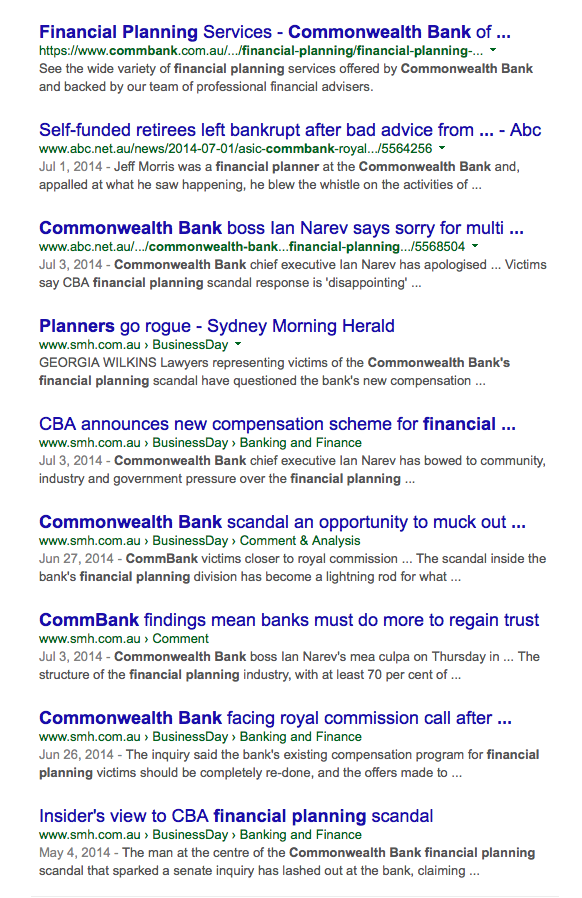
Last week we saw the government roll back the FoFA laws that were supposed to make hidden and trailing commissions illegal. Despite some wordy amendments from Clive Palmer, there is still no ironclad law that insists advisors can’t sell you a product because they get a kickback, not because it’s the very best choice for you.
Challenger brands will win with customer centric marketing
Legislation may not stop the consumer unfriendly practices of big banks. Social media and the empowered consumer will. And new technologies will see challenger brands that build financial product and service offers around what customers actually want will grow at their expense. Coles new deal with GE Capital to offer loans is just the start. I'll leave the last word to a consumer active on social media:
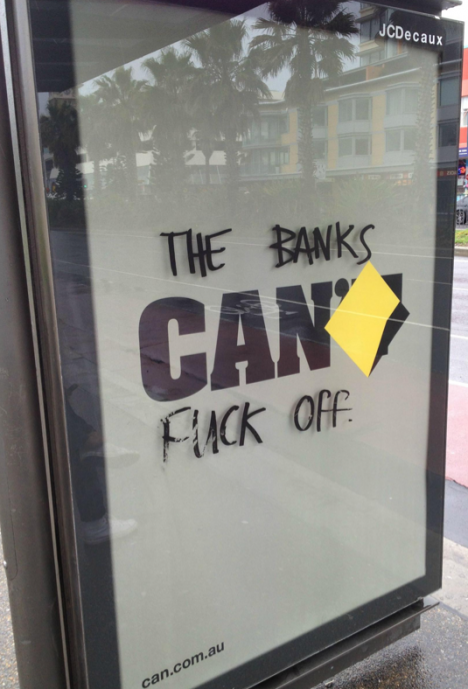
Ten biggest threats to business
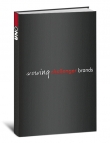
A global survey has given us a picture of what exactly the biggest challenges are for business managers today. Across categories and regions the message is the same – there are half a dozen particular issues companies are feeling pressured by, but don’t know how to deal with.
Those clever marketers at Ernst & Young have come up with a catchy way of showing what we’re all facing – they call it the Risk Heat Map.

Businesses of every size are facing the same big problems. Fortunately current research shows how your business can turn this time of rapid change to your advantage.
The real insight for business owners in this picture is that while managers recognise these risks, as we look across the Y axis we realise most don’t know how to deal with them. These challenges are the consequence of a new paradigm. There’s an elephant in the boardroom – it’s right there in the middle, emerging technologies. Yes, it’s the Internet.
Drivers of business change
The Internet has changed everything. For the first time in the history of commerce, we now have true globalisation thanks to the transparency the Internet gives customers. People can now find the truth about any product or service in just a few clicks, in the privacy of their home or using a smart phone on the shop floor.
In the recent past there was still an advantage in being big – a manufacturer could configure a product and control its availability by region, a retailer could price a product depending on the suburb. Today with instant transparency, a customer can pick and choose from what’s on offer anywhere in the world.
Brands can no longer rely on any competitive advantage from tradition, size or resources. Rather, as Boston Consulting says – “in a world of change, the spoils go to the nimble”. The key to success is not just recognising the drivers of change, it’s ACTING on them.
The biggest risk to any business today is inaction. UNO has a proven formula for growing challenger brands. We can help you start today, risk free.
Email gm@unomarcomms.com for an outline of our process.
Read MoreWhat is beauty in commercial art?

“We have a duty to keep ads beautiful” said Craig Davis, co-chairman and chief creative officer with Publicis Mojo Australia and New Zealand in Campaign Asia, yesterday.
I respect Craig, we pitched against each other for The Rocks account decades ago when we were young and radical and creative directors of competing boutique Sydney agencies. I won. The next year I pitched against him again, for Sydney Water. He won.
Personally I don’t think advertising is art. It’s Commercial art, capital C. The latest CEO survey published in the same magazine reports 80% of the region’s CEOs think marketing people “are in La-La Land”.
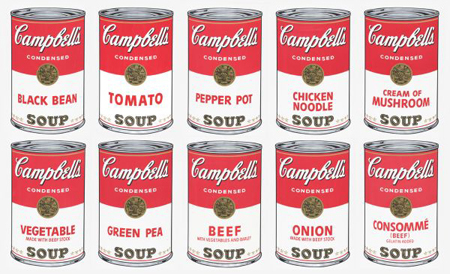
Craig’s musings on beauty in advertising aren’t going to change those perceptions. He is concerned “talent, craft and significance of ideas are being pushed aside by the desire to save time and money.” Craig makes a point worth taking the time to consider – we have all seen examples of the office junior being asked to whip up an ad because they know how to use clip art and can have it done in no time. Or the manager’s nephew is good with computers so he can build the corporate website for less.
All of this is being driven by the changes enabled by the Internet, “the flip side of the new digital meritocracy is that there’s an inordinate amount of noise generated” observes Craig.
He reminds admen “clients pay us to deliver results.” Hear, hear I say.
Then he returns to his point that “at its best, advertising is beautiful, but in the absence of creativity, it is just pollution. In the words of John Keats: Beauty is truth, truth beauty—that is all ye know on earth, and all ye need to know.”
Advertising that works is advertising that delivers a ROI
Business owners are more inclined to see beauty in numbers, like low cost per lead, and high rates of conversion. The fine balance of marketing communications is understanding how to use creativity to commercial advantage.
There is undeniable beauty in identifying a genuine human truth and expressing it to an audience in a way they find appealing. But let’s not talk about beauty for its own sake, lets talk about craft. Both in the craft of storytelling and execution, for business sake.
A century ago Dadaists like Marcel Duchamp challenged the protectors of traditional painting with the question “What is art?”
Before you invest in advertising, social media marketing or any program to grow your business, ask yourself, is this commercial art for the 21st Century? Is the execution well enough crafted to connect with your audience and leave the desired impression? Most importantly, will it give you the best return on investment?
It’s a commercial decision after all, not a beauty contest, don’t you think?
Why CEOs like Facebook yet fear it

The 2012 IBM global CEO study is just out. It once again confirms management is often aware of what needs to change, yet fear acting on their knowledge.
"CEOs need social media, but many fear it" – IBM
The world’s CEOs believe that in the next five years social media will push past websites, call centres and channel partners to become the No. 2 way to engage customers (after face-to-face communications).
However fear of change is preventing most from actually actioning a Facebook strategy. Many will miss capitalising on this inevitable trend to more agile competitors. Some fears are justified, there is no doubt there is risk involved with social media. Risk isn’t just bad ideas like CommBank’s terrorist Olympics viral video.
Advertisers are now liable for users' Facebook comments

Australia's digital industry is up in arms about a ruling from the ad watchdog, which determined a brand's Facebook page is an ad platform with all its material - including user-generated content - liable under the AANA code.
A recent ruling from the Advertising Standards Bureau (ASB) in a complaint against Diageo said it considered Facebook to be a marketing communication tool. The decision changes the landscape of social media advertising with brands liable for content generated by consumers.
In its ruling, the ASB wrote: “The Board considered that the Facebook site of an advertiser is a marketing communication tool over which the advertiser has a reasonable degree of control and could be considered to draw the attention of a segment of the public to a product in a manner calculated to promote or oppose directly or indirectly that product."
Social media advertising regulations and marketing your business
“The Code applies to the content generated by the advertisers as well as material or comments posted by users or friends.”
This is yet another example of how our regulatory frameworks are anachronistic in the era of the Internet. This new world of social media is merely a decade old, yet regulators like ASB are employing codes written in the steam age when ads were only mass distributed by printing press. Publishers had control of what letters to the editor were published with an eye on libel. But the pace of public postings on Facebook makes such a process for an editor of a business Facebook page less that of a publisher, more one of the town crier who invites people to the town square but can’t predict what the crowd will yell about loudest.
Right now the judiciary has similarly lacked an ability to adapt as the public circumvents contempt of court rules and out accused on Facebook, passing collective judgement before a trial. No blurred pictures of the accused’s face like in the press or on TV. Think the Kings Cross king hitter, perhaps fuelled by Diageo products. Lets see a post on a liquor brand’s Facebook about the next alcohol induced murder and ponder the consequences. It's going to happen, irrespective of what the ASB stipulates.
So if CEOs are going to increasingly use Facebook for a dialogue with prospects, we will need to be extremely diligent to keep on the right side of the law, irrespective of how sensible we think regulations are today.
Learn from Darrell Lea's Rocky Road

Darrell Lea's new Perth concept store opened in March. Too late to keep the administrators from the door?
Most business leaders know the 4 Ps from marketing 101. As Darrell Lea’s predicament shows, in today’s marketplace where change is underway at an increasingly blistering pace, keeping those easily understood basics working in your favour is becoming increasingly difficult. Here they are one by one:
Product
Mega trends like multiculturalism, gourmetisation of food products, better for you choices, and social issues like fair trade today shape what we choose to eat.
In the past it was enough to make minor adjustments to products and expect a sales lift simply by placing a NEW IMPROVED flash on the wrapping. For the last couple of decades there’s been little in the way of product innovation at Darrel Lea. As well intentioned as they may have been, small line extensions like fruit flavoured liquorice haven’t been enough to stop the sales decline.
Businesses have to be wary of who they entrust to give them independent counsel. Darrell Lea invested in research that resulted in a new tag line, “85 years of creating sweet magic”. One can argue this simply reinforced a backward looking management mindset.
Today customers are rewarding brave leaps forward in categories. As Max Brenner’s website proclaims, “Chocolate is not just about taste” it’s also about fashion. From Mexican spicy chocolate and hot chocolate shots to chocolate soufflés and Tiramisu, Australians are spending more money on chocolate than ever before as brands can come up with new adventurous ways to tempt them.

Challenger brands aren’t just new companies doing new things, old companies doing things differently are also being rewarded. Australia’s oldest chocolate maker/retailer, 97 year old family business Haigh’s has kept customers coming back and continues to entice new ones with adventurous new takes on chocolates.
Promotion
Cutting back on advertising for a short term cost saving is proven to come at a long term significant loss. Once a significant investor in advertising, Darrell Lea has been absent from mass media marketing for several years. It takes many years to build a brand and nanoseconds to damage one in social media. It pays to treat advertising as a compounding investment that pays an annuity in return.
Price
Too often price is only mentioned in the same sentence as promotion. It is in fact a two way lever. A 4 for $15 offer on Rocklea Road isn’t going to entice a new customer, it simply reduces the margin on a sale to an existing one.

Whereas Lindt, once considered a niche special occasion brand, has grown by offering a variety of chocolate balls across a range of pricepoints and product sizes that still maintain a premium.
Place
The Internet is making everyone reconsider where is the best place to make a sale? Ecommerce may not be right for a product that will melt in the mail, but is owning a shop the best alternative? Why own 63 shops when most chocolate sales are through Coles and Woolworths and convenience stores?
If you are going to have a retail outlet, it needs to have a good reason to justify the high overheads. Darrell Lea’s average over the counter sale is around $11 per customer. You’d need a lot of footfall to justify the rental on the King and George Street Sydney store. On the opposite corners are the eye candy Apple store and Louis Vuitton, where the products cost thousands (and are never discounted).
Challenger brands understand stores are the new 3D interactive ad medium. They are all about theatre and entertainment. Max Brenner has the theatre of their liquid chocolate Willy Wonka-esque stores.
Other retailers realise the store is simply the best way to gather new customers details for database driven online sales. The objective of the shop front is to entice prospects in and the brief to staff is to start a long-term relationship. For instance, banks lose money on physical branches, but haven’t found a better way to gain new customers. Citibank’s new branches in Hong Kong have been designed by the same architects as the Apple Stores. You can’t make a deposit at one of these new gleaming white banks with couches and interactive screens, you can have an espresso made by a barrista who is briefed to cross sell financial products to you.
How to stay competitive
Many market leaders are vulnerable to the threat that comes from failing to re-look at their entire business models. Simply reviewing the 4 Ps from the perspective of traditional wisdom will no longer ensure a business stays competitive. Market leaders that fail to embrace change, not just across product and service but entire systems and relationships, are increasingly less profitable than smaller challenger brands. There are a number of proven tools and techniques to help businesses rapidly adapt and trial new ways, feel free to ask us about some of them.
Boston Consulting has formally identified what savvy marketers know is the driver of business growth today:
In a world of change, the spoils go to the nimble*
*Martin Reeves and Mike Deimler, Boston Consulting Group,
Harvard Business Review July-August 2011

Founded in Adelaide by Alfred E Haigh in 1915, Australia’s oldest family-owned chocolate maker/retailer has a history of embracing change.
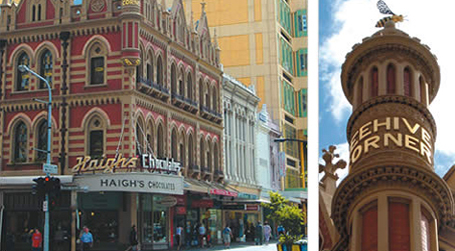
In the 1950s grandson John learned from Swiss masters Lindt and Sprungli and introduced European fine chocolate making to Australians. The current fourth generation Haigh family management preside over a business that represents barely 1% of Australia’s chocolate sales. Yet I would venture to say they are very profitable.
By continuing to innovate Haigh's continues to prosper as a challenger brand
Their award-winning Australian Collection was launched in 2003, with six native food centres including quandong, macadamia nut and honey, lemon myrtle and wattle seed. And as Australian’s have become more sophisticated in food tastes, Haigh’s have kept up with such adventurous chocolates as a South Australian truffle duet made with premium wines from the State’s wine regions.
Haigh’s environmental policies and sponsorships are just one indicator of how in touch this old business is with today’s consumer.
Last August at the Family Business Australia Conference, Joint Managing Director Alister Haigh told me they were ready for the next big change - online sales. The only sticking point is developing a delivery method that can guarantee the integrity of their heat sensitive product.
Following the biggest fine in UK finance history, it’s timely to look again at Barclays’ Big Ad

Barclays agreed to pay a record $442 million fine for rigging the London interbank offered rate last month. The scandal has cost the jobs of Barclays CEO Robert Diamond (below), Chairman Marcus Agius, and Chief Operating Officer Jerry Del Missier.
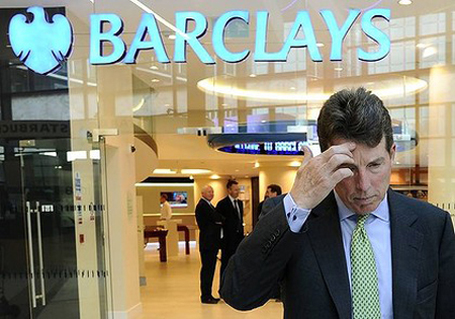
It pays to consider the future consequences of a single-minded marketing tagline. For Barclays, “We’re Big” just doesn’t cut it anymore.
If you're a marketer, Read This Or Die...

A friend sent me a YouTube link via Facebook – a comedy sketch by Bill Hicks, where the comedian asks anyone in the audience that’s in advertising or marketing to “kill yourself".
I was reminded of my profession’s tenuous grip on social acceptance when this week leading researchers Roy Morgan released their latest annual survey of how Australians rate the professions: ad people are still near the bottom, just above car salesman.
There is still hope for Admen and marketers – it’s about having conversations at the board level that explain in understandable terms how we can add value. This week McKinsey Quarterly published a checklist of 5 things that will help business managers get the best ROI from their marketing.
So for those who rate the wisdom of McKinsey's consultants, here in my words are the 5 tips that will make any CEO take you seriously.
1. What exactly influences our consumers today?
Mass media marketing to the masses is oh so yesterday. Thanks to the Internet, shoppers now consider options at more times in more ways, from reading online reviews to comparing prices when in-store using their mobiles. Once someone has bought something, they potentially become a reviewer themselves.
So how do you get into the new consumer's head? You can use anything from traditional research to online polls or social media tracking to get a better understanding of what consumers are now thinking about a category. The key is to be open minded about what you learn and have a management team willing to let go of accepted wisdoms.
2. How well informed (really) is our marketing judgment?
It was only a decade ago when traditional advertising was all that mattered. Marketers who new their stuff could make decisions safe in the knowledge what always worked in the past probably would tomorrow. And planned accordingly. Today you have to be able to recognise signals of change, and act on them. This means managers have to move out of their comfort zones and hypothesise, test new ways, then measure, analyse and adapt. Again and again. In McKinsey’s words there has always been a a need to define a “clear relationship between marketing spending and business results”. Today it has shifted from “should we be spending on marketing at all?” to “what’s the optimum marketing spending needed to hit our targets?”
3. How are we managing financial risk in our marketing plans?
Successful marketing communication takes hitting the right audience with the right message at the right time. The difference today is the targets are increasingly individuals and they are moving faster than ever. Traditional mass media allows advertisers to minimise risk by using metrics based on years of surveys that measure frequency and impact of a particular medium. Not so now. With today’s new media “influence can shift rapidly, and there is little accumulated experience about which messages work, when marketers should apply them, how they can be scaled, or even whom they influence”.
Measurement and risk reduction today comes from a closer relationship between sales and marketing and the channel. One of our clients has found scan data has new meaning now it can be overlaid with pre and post campaign brand tracking and the incredible analytics available using Shopperpedia.
4. How are we coping with added complexity in the marketing
organisation?
If you think it’s hard to keep up now, it’s only going to get harder faster. McKinsey's unsurprisingly suggest “you’ll require a number of specialists. You can’t get the skills and knowledge you need in just one person, and you’re not likely to get everything you need internally”.
5. What metrics should we track given our (imperfect) options?
At this point McKinsey goes into a whole grab bag of consultant speak. At UNO we think it best to get back to business basics – success should be measured by profit, not volume of sales or market rank. A business is successful when it can compete on more things than just price. And it knows it’s a real challenger brand when staff and partners are aligned and customers are referrers.
Now if you’re in advertising or marketing and you can’t get your head around the idea you have to change to survive, take a couple of minutes to laugh out loud as Bill Hicks encourages you to kill yourself
Where the smart budgets are being spent...Social Media
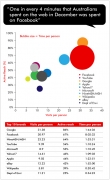
Have you noticed over the last decade that just about anything that isn’t nailed down has been digitised. Today we can access nearly everything from anywhere on anything – from getting the news on a tablet, trading shares on a mobile or accessing software services from the cloud. Plumbers are relatively safe, but most other businesses have to change.
The difficulty for business managers though is not just deciding how to make the change to digital, but how to make money out of it...
Pew Research Centre in the United States found that digitisation is burning money
Newspapers lost $10 in print ad revenue last year for every $1 they gained online. Just five companies, none of which existed a couple of decades ago are now taking 68% of online ad revenue: Google, Microsoft, Yahoo, AOL and Facebook.
Marketers know that they need to integrate traditional mediums with digital. Few businesses actually do – and some still think online is primarily for brands with young customers.
Businesses may be surprised to discover that the place where Australians spend the most time online, is also the most popular with women 25-45 years old.

The papers continue to spend money on journalists and creating the content, while these new companies continue to grow their revenue off the papers’ labours. Now because of their growing databases, fuelled by an understanding of people’s behaviour and preferences gathered from social media use, the digital intermediaries can now target ads more precisely than the old publishers.
The things we can now do on Facebook are incredible. In the past only advertisers who could afford to buy expensive data and research could precisely target their consumers. Now any advertiser can pretty well plan as effectively as the global giants by tapping into the growing wealth of intelligence of the social media technologists.
The Pew report says: “Two trends in the last year overlap and reinforce the sense that the gap between the news and technology industries is widening. First, the explosion of new mobile platforms and social media channels represents another layer of technology with which news organisations must keep pace. Second, in the last year a small number of technology giants began rapidly moving to consolidate their power by becoming makers of 'everything' in our digital lives. Google, Amazon, Facebook, Apple and a few others are manoeuvring to make the hardware people use, the operating systems that run those devices, the browsers on which people navigate, the e-mail services on which they communicate, the social networks on which they share and the web platforms on which they shop and play. And all of this will provide these companies with detailed personal data about each consumer.”
Business journalist Leon Gettler points out “Newspaper groups like Fairfax are the canaries in the coal mine for other industries facing similar challenges, from book shops and publishing to health care, industries where barriers to entry are low and where information is the main product. The trend to digitisation will accelerate with 'Generation C', people born from 1990 on who expect to be constantly connected through every possible device now entering the workforce, and with costs of computing and technology equipment dropping.”
“In every organisation, from media to retailers like David Jones, Myer and Harvey Norman, the biggest challenge always comes down to the tension between those who advocate a more aggressive approach and those aligned with legacy traditions, those who want to go fast and those who want to slow down.”
Adaptability: the new competitive advantage
As the pace of change accelerates, adaptability becomes the new competitive advantage. Long established leaders like Kodak, Borders and Fletcher Jones are a lesson in what management can expect if they don’t change their business model to integrate digitised marketing with their traditional methods.
Sources: Leon Gettler, Business Spectator, 28/3/12
Pew Research Centre, How Newspapers Are Faring Trying to Build Digital Revenue, 5/3/12
Why are marketers using Smartphones today?

The answer is in the numbers, and is a pointer to the next big thing.
Google researched 300,000 people around the world to find out their Smartphone use. Now as Australian marketers we can compare and contrast markets.
Number 2 for Smartphones in the world
Australia is now ahead of the US, UK, and Japan.
Average Smartphone under 12 months
Most of Australia’s Smartphones were purchased in the last 12months. We’ve gone from the back of the pack to the second highest penetration of this technology in the last year. Every month 1-2% of the entire population of Australia buys a Smartphone.
81% do it at home
More Australians used their Smartphones at home during the past 7 days than out – just 66% use them on the go.
50% like to watch
Almost 1 in 2 use their Smartphone while watching TV, while 1 in 3 use Smartphones and another Internet-enabled device at the same time. Talk about adult ADHD media consumption.
Smartphones are good for business
49% use their Smartphone to research and then call businesses – and 45% visit a business they’ve found using their Smartphone.
Aussies are obsessed with real estate
The stats confirm what we’ve all known from dinner party conversations – 1 in 5 Australians surveyed had looked for an apartment or house with their Smartphone – that’s 33% higher than the US or UK.
40% search daily
2 in 5 of Australian Smartphone owners use mobile search daily, that’s more than the UK or Germany and almost as high as the number who use desktop search daily.
The number of queries about retailers made via mobile devices has jumped 220 per cent year on year, and is now about 25 per cent of all queries.*
App, app and away
Australian survey respondents had 25 apps on average per Smartphone, Vs 23 in the US & UK. We’re not just talking free apps; Australians averaged 8 paid apps per phone.
TV or not TV?…
1 in 5 Aussie Smartphone owners would rather give up their TV than their Smartphone.
Better than sex?
1 in 3 say so according to a Telenav survey, that’s how many would choose their Smartphone rather than sex.

Now you’re up to speed with the omnipresence of mobile you’ll need to start thinking about how you can extend your online activity beyond a website that is viewed on a PC.
But wait, there’s more. Nothing stands still nowadays; to keep up you also need to be thinking of how to stay ahead of the competition.
So what’s next?
In just a year Australians have learnt to surf the web, send emails and watch movies on a Smartphone. Now consumers are moving to tablets because they are more convenient than laptops and obviously have a bigger screen than Smartphones.
1.2 million this year
In 2011 tablets will outsell Smartphones in Australia. 64 million tablets will be sold worldwide by the end of this year. #
73% of them will be iPads
Apple will sell 47 million iPads this year.#
We believe video to mobile devices is a game changing opportunity for challenger brands. Until now many marketers have been held back by the high cost of entry of mass media advertising. The amount of media consumption online has risen from 25 per cent in 2007 to about 42 per cent now. A new buzzword for marketers in the US is ''SoLoMo'' – as in social media, local networks and mobile. Savvy marketers are recognising the need to develop strategies that make the most of these new, powerful mediums. *
We believe you can now punch above your weight more effectively than ever by integrating video and content to create a genuine one-to-one dialogue on customers’ mobile devices. You’ll be surprised what is now possible…
50% conversion rate
50 per cent of people who inquired about a hotel via a mobile device went on to make a booking within a couple of days, compared with 20 per cent for those online via a computer. *
Give me a call on my Smartphone, 0412 982 538, if you’d like to know more.
*Ross McDonald, Google, 9/12/11
#Gartner, 8/12/11
"Greenwashing" Why a great idea that isn't true is a bad idea


What a shame this great ad for Steggles wasn’t for a producer of real free-range eggs. It was pulled because it’s a lie, even though beautifully told. Every person in every agency should be stegglers for detail.
The public deserves better than marketers passing off intensively “farmed” produce as free range when there isn’t room for the animal to scratch itself. “Greenwashing” takes many forms, like adding the claim Hormone Free to chicken packs when it’s been illegal to add hormones to any farmed chicken in this country since 1968.
At the moment here at UNO we are working on a campaign for an Australian innovation, the first plastic to biodegrade in modern landfill, which is where a billion disposable coffee cups end up each year across our country. We have told our client he can succeed as a challenger brand by telling the truth. There will be no green washing, just the facts about what this product can and can’t do. And we’ll do that the way all ad people should, with creative wit and human insight.
J Walter Thompson’s words of over 100 years ago are as right today as ever – “The truth, well told” is why we get up in the morning.
See the vodcast about what makes biorene biodegradable – the Earth eats it up!
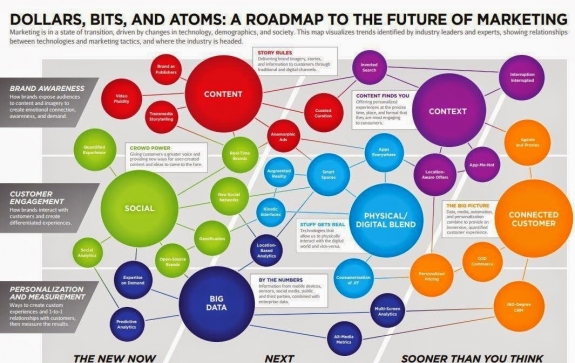




Scan the QR code for our contact details.
Download the Neoreader app.
© COPYRIGHT 2013 UNO marcomms Privacy